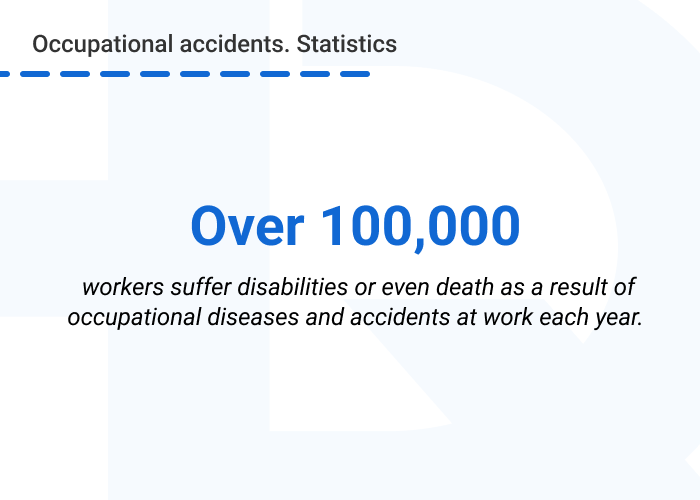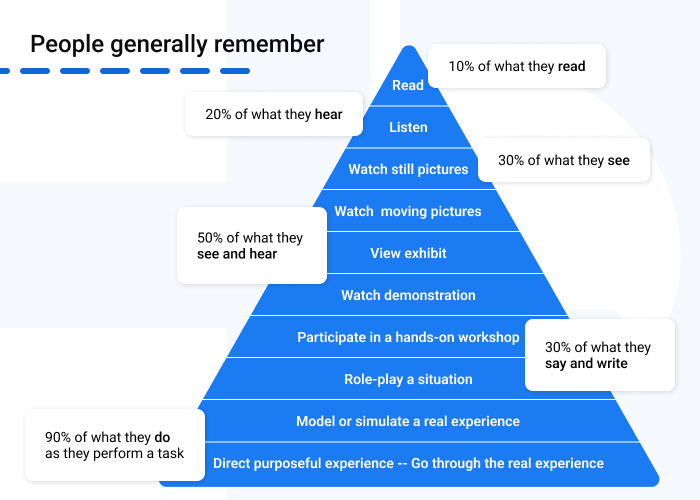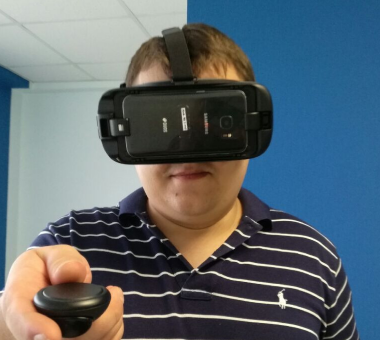Advantages of Virtual and Augmented Reality Employee Training
Practical learning of hard skills
Enhancing advanced soft skills with AR and VR training
Limitations of physical space, lack of hands-on practice, and inability to play out dangerous scenarios are only some of the gaps in traditional training for employees that Augmented Reality (AR) and Virtual Reality (VR) can address.
Although some businesses still offer traditional training approach, an increasing number of companies are recognizing the numerous benefits of AR and VR for training. These advantages include, for instance, enhanced hands-on learning and the ability to explore situations that are difficult to simulate in the real world.
Read on to explore other compelling benefits of Virtual and Augmented Reality for training and the many ways they can improve corporate skills with our VR development services.
Advantages of Virtual and Augmented Reality Employee Training
Practical learning of hard skills
Enhancing advanced soft skills with AR and VR training
AR/VR training benefits are due to their strong sensory engagement which can foster deeper learning. They provide a “learn by doing” approach that helps employees transfer theoretical knowledge into practical application.
The immersive nature of AR and VR allows employees to engage in realistic training scenarios, enabling them to acquire needed skills in a more effective manner. About 61% of users claim that using AR/VR training simulations helps them better understand their job.
Some other advantages of Augmented Reality training and VR learning include:
Often new hires don’t have access to real objects, environment, or equipment to train. It can be complicated or costly to provide, especially when the trainee makes mistakes.
AR/VR training allows your employees to practice in a virtual environment that is close to the real-world setting. AR and VR training in the workplace can simulate complex operational scenarios, life-threatening situations, equipment operation, etc. So, employees can experiment, make errors, and learn from mistakes without any negative consequences.
Within an immersive platform, employees can repeat the process until they achieve proficiency. This builds muscle memory and fosters a deeper understanding of technical concepts.
At HQSoftware we have engineered occupational training for developing new technical skills such as cylinder head disassembly and assembly and propeller inspection and repair. Using VR for training, new employees can acquire relevant capabilities before using them in the actual workplace in the aviation and mechanics sectors.
This interactive learning process with our solution promotes an 84% engagement rate and 67% knowledge retention.
While modeling situations in a classroom to practice soft skills may seem effective, this is not always the case.
For instance, when they are role-playing conflict situations, participants might fear offending their colleagues or displaying bias. It can be challenging for employees to authentically portray the strong emotions, for example, of an angry customer. Ultimately, some employees may feel uncomfortable being the center of attention, especially in the presence of people they know.
By using VR, employees can practice complex communication scenarios in a safe environment without real-world consequences.
Virtual and Augmented Reality coaching offers virtual characters or avatars with which trainees can practice communication, active listening, conflict resolution, and empathy in a simulated environment.
Moreover, in Augmented and Virtual Reality employee training, you can create scenarios to train workers to handle customer inquiries, resolve issues, and deliver sales pitches. This helps your employees improve their communication skills, leading to enhanced customer service and higher customer satisfaction and loyalty.
Need to enhance your training program with visual and interactive experiences?HQSoftware has a team of skilled professionals ready to tackle the project. Ask me!
Anna Halias
Business Development Manager
Customer service representatives at Verizon’s contact centers employ VR training to practice de-escalation techniques. Before, they relied on traditional training. However, it was not as effective as it could be, because trainers struggled to express real anger while playing the role of an unhappy customer.
To address this problem, the company decided to portray emotions using virtual avatars of angry customers in VR. This allows service employees to grapple better with customer frustrations and react accordingly.
VR training gives Verizon employees experience dealing with various behavior patterns and doing so with self-assurance in a secure environment.
In VR, employees can work in a secure environment without any risk of causing harm to themselves, equipment, production, or co-workers. So, learners feel safe and less stressed, fully concentrating on the learning process and not afraid of making mistakes.
Also, in VR you can create lifelike experiences to train staff to respond correctly in stressful, high-risk, and difficult-to-replicate situations that call for quick thought and decisive action.
This is highly important if your production involves hazardous materials or potentially dangerous working conditions. In Augmented and Virtual Reality employee training, users can experience electrical hazards, chemical spills, or aircraft fire, and learn how to handle them.
Employees who receive this training will be better equipped to identify possible dangers early on and take the necessary precautions to avoid accidents and injuries. In fact, over 100,000 workers a year suffer disabilities or even death as a result of occupational diseases and accidents at work.

Since 2018, Verizon has been providing such safe VR training for technicians. By being immersed in realistic VR scenarios, such as working on fiber splices or repairing optical network terminals, employees can train in challenging but safe settings.
Through comprehensive training, they acquire the skills needed to confidently perform their daily tasks. Additionally, employees train how to react effectively to potential risks and hazards.
Keeping trainees engaged and focused throughout a learning session is one of the biggest challenges for any instructor. The typical approach involves reading and listening. However, Dale’s cone of experience explains that people retain on average only 20% of what they hear and only 10% of what they read.

Instead of passively consuming information, employees using VR actively participate in learning. They can interact with virtual objects, perform tasks, and make decisions. Therefore, VR trainees are 40% more confident in applying new skills compared to learners using the traditional approach.
To make AR and VR training even more engaging, you can incorporate gamification elements, such as points, rewards, challenges, and leaderboards. Through interactive simulations and a score-based achievement system, trainees may become motivated to complete tasks faster and progress through courses better.
Virtual and Augmented Reality training eliminates the need for dedicated physical training spaces, material, and numerous high-qualified instructors. The research demonstrates that VR costs can be 52% lower than classroom-based training.
Instead of physical classrooms, employees can access training modules through VR headsets or AR-enabled devices. This requires only a small dedicated space, or none at all if the training can be performed at home.
Despite the initial equipment costs, there are several reasons why VR training can pay for itself economically:
As stated in the report, VR training will make a substantial contribution of £ 1.4 trillion ($1.78 trillion) to the global economy by the year 2030, making immersive learning one of the leading future tech trends.
How do modern businesses use AR to increase their revenues and outperform their industry competitors?

To effectively illustrate the benefits of AR and VR on employee training, we compared it to traditional learning in the table below.
|
AR/VR Training |
In-Person Training | |
| Type of training | provides simulations for practicing skills in a controlled environment that closely resembles real-world scenarios; | offers basic practice with physical objects in a real-world environment under supervision; |
| Accessibility | can be accessed anywhere at any time on specialized devices; | requires gathering many employees in one place, considering their schedules, and requires traveling to a physical location; |
| Cost efficiency | eliminates expenses for physical equipment, space, and dedicated trainers for each session. But requires spending on VR helmets and AR/VR glasses; | necessitates additional money for instructors, physical learning materials, and other necessary arrangements; |
| Engagement | stimulates audio, visual, and haptic senses, making the learning process interactive and more engaging; | provides standard learning methods, such as reading textbooks, watching videos, ot taking quizzes; |
| Performance feedback | automatically collects performance metrics. | relies on manual tracking and assessment by instructors. |
As you can see, the AR/VR approach combines the strengths of both methods, becoming an optimal learning option with maximized efficiency.
By partnering with HQSoftware, you can create customized AR/VR software that will address your company’s unique challenges and objectives. Our deep domain expertise is backed by numerous AR and VR training solutions across multiple industries.
However, we can be responsible for more than just the technical part. Our educational design expert can create tailored training scenarios from scratch that effectively meet your objectives.
Schedule a consultation and find out more about how we can help you develop best-in-class AR/VR training software.

AR/VR Expert
A developer with extensive expertise in AR/VR, very ingrained into the topic of Mixed Reality development. Shares his knowledge and the results of many years of work.
We are open to seeing your business needs and determining the best solution. Complete this form, and receive a free personalized proposal from your dedicated manager.

Sergei Vardomatski
Founder